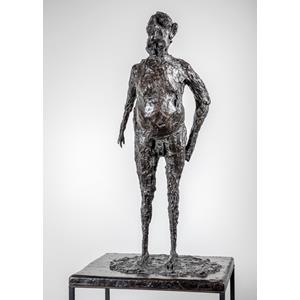DÉTAILS DE L'IMAGE

Galerie de la Béraudière
Germaine Richier (Grans 1902-1959 Montpellier)
L'Ogre, 1949
Bronze with black patina
H 81.2 x W 45 x D 40.3 cm
Signed and stamped on the base: G Richier, C. Valsuani cire perdue
Foundry: Claude Valsuani, Paris, conceived in 1949, cast in 1951
Edition of 12 (1/8 – 8/8 + 4 AP )
Original certificate of authenticity by Francoise Guiter, dated 5 March 2014
Provenance: Galerie Creuzevault, Paris (1962); Galerie Odermatt, Paris; Sale Prescheteau-Badin, Paris, 20 March 2006; private collection
Important literature on request.
This work by Germaine Richier is particularly remarkable because it represents a crucial period in the artist's career, the post-war period, which marked a transition from a still traditional and classical treatment of form to a phase when Richier's creations were increasingly detached from naturalism. The bronze is a good example of Richier's way of working at this time, and still bears the traces of the artist's 'struggle' with the material. There are many holes: the mouth, for example, is made gaping by strong pressure from the thumb. The single eye (because the Ogre is also a Cyclops) is reduced to an enormous cavity. The whole of the Ogre's body is made up of tears in this way, a particularly good example of this fundamental passage in Richier's creation.
Far from the naturalism of his beginnings, the humanity depicted by Richier took on a different aspect, revealing a tragic vision of reality. Man is flayed alive and torn in his own flesh. Surfaces are gnawed, shredded and perforated, in an aesthetic that blurs the line between figuration and disfiguration. While Germaine Richier's formal research followed in the footsteps of her illustrious predecessors, the renewed expression of the human in her work, of which L'Ogre is a magnificent example, echoed the existentialist questions of post-war society and recomposed the divide between abstraction and representation.
The first woman artist to have an exhibition at the Musée National d'Art Moderne in her lifetime, Germaine Richier enjoyed a meteoric career and several prestigious exhibitions, the latest of which was the major retrospective held at the Centre Pompidou in 2023. This touring exhibition, which continues until 5 November at the Musée Fabre in Montpellier, featured a major drawing related to this statue, depicting the same silhouette masterfully defined by the artist.



 TÉLÉCHARGER L'IMAGE
TÉLÉCHARGER L'IMAGE